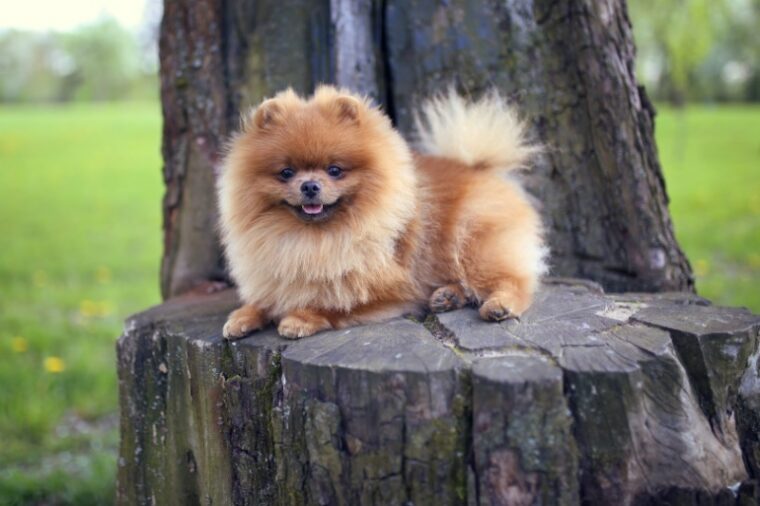
Click Below to Skip Ahead
The Pomeranian is a tiny dog breed that originates from larger sledding breeds. This companion dog is tiny and is intelligent, playful, and energetic. It is well suited to life in an apartment (although do be aware of its tendency to yap a lot) but is more independent than a lot of similarly sized breeds, which makes it popular with older owners, as well as those that go out to work and are not at the dog’s beck and call every day. Its minute stature means that the “little dog who thinks he can” is not suitable for families with very young children.
Breed Overview
Height
8-11 inches
Weight
3-7 pounds
Lifespan
12-16 years
Colors
White, black, red, gray, cream, tan, brown, blue
Suitable for
Individuals and older families looking for an independent companion
Temperament
Friendly, sociable, playful, intelligent, independent
As well as being energetic and playful, the Pom is intelligent and likes activities that tax its mind and body. It does well in agility and other suitable canine classes.
Read on for more information on this plucky little character and to see whether it would make a suitable pet for your home.
Pomeranian Characteristics
Pomeranian Puppies
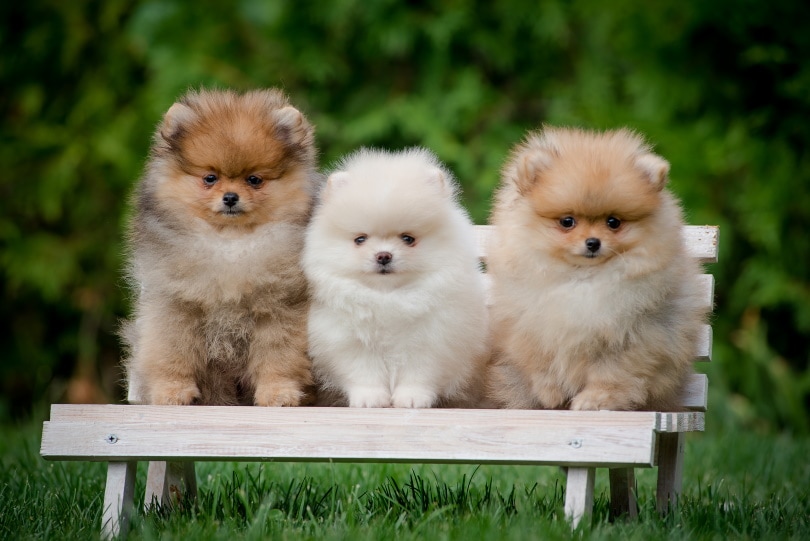
Determine whether you are looking for a companion or a dog to exhibit. Exhibiting a Pomeranian means that they must adhere to strict breed standards, including size and appearance. Pet Poms don’t need to meet these same guidelines.
Look for an appropriate breeder using social media, breed clubs, and breed registries. The American Pomeranian Club is active in the USA, and the Pomeranian Club UK is the UK’s official registry. Breeders must meet standards regarding welfare, health screening, and other factors to be accepted and remain on the registry breeders’ list, offering some assurances to potential owners.
When meeting a breeder, look at where the dogs are bred and where they are raised for the first few months of their life. Ideally, they will be kept indoors. The puppies should be alert and while they may be naturally nervous when meeting new people, they should not be scared. Ensure that you meet at least the mother, and ideally any siblings that have remained with the breeder.
Although the Pomeranian breed is a thoroughbred, these little dogs are often found in shelters and rescues. Often, they were pets to senior owners who were, unfortunately, no longer able to properly care for the dog, or they may have passed away. However, in other cases, the dog may have been left because the breed does have a propensity to bark a lot and some can be aggressive towards other dogs.
Temperament & Intelligence of the Pomeranian
The Pomeranian is a small dog and, in terms of its size and energy levels, adapts well to life in an apartment. However, the breed is known for barking a lot, which could annoy close neighbors. It is also a good idea to avoid hot weather and to ensure that the Pom gets plenty of daily exercise and mental stimulation. Provide this small dog with love and it will return the affection.
Are These Dogs Good for Families? 👪
As a very small breed, care must be taken around young children. It doesn’t take a lot to cause injury to a Pom, and they may respond to tail grabbing by nipping at toddlers and young children. They will appreciate the energy of older children, especially those that are willing to throw a ball, take them for a walk, or pay them attention. The breed is favored by seniors and by individuals and families that work because it does have a somewhat independent nature and doesn’t need constant attention and nurturing.
As long as you can provide regular exercise and plenty of love, it will fit into your family group.
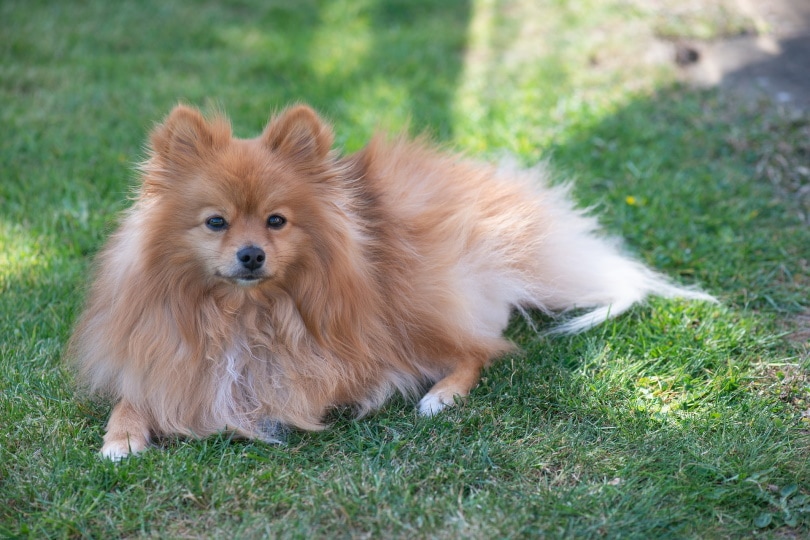
Does This Breed Get Along with Other Pets?
The Pom is a small dog that believes its size is much larger. As such, it may challenge larger dogs in the dog park or on walks. Early socialization can teach the Pomeranian better canine skills.
However, at home, this plucky little breed will get along with other dogs, can become close friends with cats, and should not pose much threat to any household pets, although you should never leave very small animals unaccompanied with dogs.
Things to Know When Owning a Pomeranian:
The Pomeranian makes a great companion for owners of all ages from respectful children up to senior owners. It gets along with the other dogs, and even cats, in its family, and can adapt to life in an apartment, as long as you provide it with enough physical and mental stimulation to curb the potentially incessant barking.
However, it does exhibit this tendency to bark and can be quite independent. Below, you will find more details on Pomeranian ownership to help you decide whether this is the right breed for you.
Food & Diet Requirements 🦴
As a tiny breed, the Pomeranian has a small appetite. This means that you will only need to feed approximately half of a cup of good quality kibble each day. Ensure you choose good food that meets all the breed’s requirements and that is considered nutritionally complete.
Because the dog is so small, it can be very easy to overfeed. This is especially true with treats and supplementary food. Even a small amount of extra food is equivalent to a decent portion of the Pom’s daily recommended intake, so choose low-calorie treats and feed them in small portions.
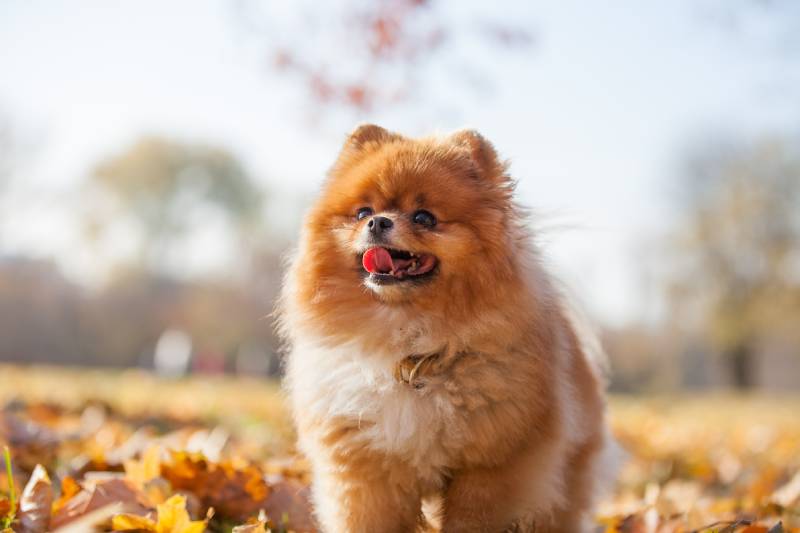
Exercise 🐕
Similarly, although the breed is lively and energetic, it doesn’t require too much exercise. You need to remember that your pup only has very small legs, so what might feel like a moderately energetic walk to you is likely the equivalent of a marathon run to your dog. Provide 45 minutes of walks each day, ideally over two walks. Your Pom will also enjoy other physical activities, such as chasing a ball or playing with toys. You should take care leaving a Pomeranian unattended in a yard because its size means that it can fall prey to larger animals, even including large birds of prey. If you do have a fenced yard, ensure that your dog is accompanied while outside.
Another factor to consider is that the Pomeranian can struggle with hot temperatures. If you are going on a walk on a hot day, take it slowly and allow breaks. Always ensure that you offer access to fresh drinking water, especially when you do get back from exercising.
Training 🎾
This small breed makes a good watchdog because it tends to bark at people and noises that it doesn’t recognize. While this is good for a watchdog, it is not ideal for neighbors; and if you want to avoid this problem, you will need to use positive training from a young age. Ignore your dog when it barks, praise and reward when it stops barking, and be consistent with the training.
The Pom is intelligent so is definitely trainable. However, they do have a short attention span. Keep training sessions short and enjoyable to ensure maximum effort and attention. Avoid longer sessions because your Pom will lose attention which may mean that you lose the benefit of any successful training.
Socialization is an important part of the development of any young dog. It introduces them to situations, animals, and dogs, that they have not experienced before, and it teaches them how to behave in these conditions. Socializing a Pomeranian can help avoid the barking problem because your dog will be less intrigued and concerned by new situations and people. It can also teach your Pom that it is a small dog and should not challenge bigger dogs when out walking.
Once used for pulling sleds, the breed has been bred down to a much smaller size, but it does retain some of the physical traits. In particular, it enjoys structured exercise, which is why you will see Pomeranians taking part in agility and training shows. Agility classes represent another good opportunity to socialize your dog and provide training while also strengthening the bond between you and burning off excess energy.
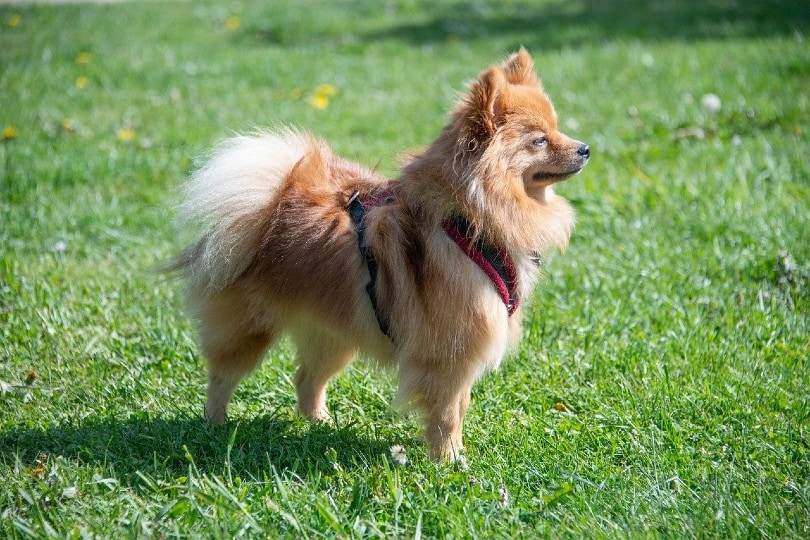
Grooming ✂️
The double-coated Pomeranian has a thick undercoat. The hair around the neck and chest is even thicker, and it has a plumed tail. They will usually shed once a year. Brush twice weekly with a metal comb and a wire brush, ensuring that you brush from the skin to the tip of the fur. This ensures that the coat’s natural oils are dispersed fully through the coat, providing protection, and ensuring that the coat is full and healthy.
Some owners do choose to trim the feet, face, ears, and rear end. This isn’t necessary but it does improve overall neatness, so it is up to you.
Dogs need help with dental and claw maintenance.
Brush teeth at least three times a week, and trim nails every two months or more often if required. Ideally, you should start brushing teeth and clipping claws when your Pom is a puppy. Otherwise, the concept of putting a brush in their mouth or having sharp scissors near their feet can stress your dog out and make the whole process more difficult.
Health and Conditions 🏥
The Pomeranian is considered a hardy and healthy breed, although you do need to keep it out of extreme hot weather. With that said, like all breeds, it is predisposed to certain genetic conditions. The most common Pom health problems are:
Male vs Female
There is very little size or cost difference between male and female Pomeranians, although the male can be more muscular than the female.
Some owners claim that the male is more playful and fun-loving but also more demanding than the female. The female is considered the more independent of the genders and may also be more intelligent and with a great attention span, making them easier to train.
However, individual characteristics are far more likely to determine the character of your pup, rather than gender.
3 Little-Known Facts About the Pomeranian
1. They Come In More Than 20 Color Combinations
Tan and orange are the most widely recognized and available colors, but the American Kennel Club recognizes 23 different color combinations. These colors include chocolate, black, sable, and white.
The reason for there being such a wide range of accepted colors could be that the breed is prone to changing colors as the dog ages. Many light-colored Poms are born white, or nearly white, and darken as they age. It is impossible to precisely predict what color your pup will be when it gets older, although genetics do play a big part in the transformation.
It is worth noting that the blue Pomeranian is not blue but is named for the blue tinge to its nose and because it may have blue eyes, as well. The fur of the dog tends to be black.
2. They Have Had Some High-Profile Owners
As well as inspiring classical composers, including Mozart and Chopin, famous Pomeranian owners have included Michelangelo, whose Pom sat and watched him paint the Sistine Chapel; Queen Victoria, who is credited with breeding them down to the size they are today and popularising what was previously an unpopular breed; and Teddy Roosevelt.
Other celebrity Pom lovers include Paris Hilton, Kelly and Sharon Osbourne, LeAnn Rimes, and even Sylvester Stallone.
3. Pomeranian Ancestors Were Sledding Dogs
It is difficult to believe, looking at their tiny frame and slight size, although their can-do, somewhat bolshy attitude would certainly hint at a time when they were bigger than their current stature, but the Pomeranian is a Spitz dog. As such, they are related to breeds like the Husky.
While the modern Pom weighs about 6 pounds, the original breed weighed 20 pounds or more: not only would they have pulled sleds, but they would have herded reindeer, too. Their herding history might explain their barking and the fact that they are more than willing to go toe-to-toe with much larger dogs.
Although unlikely to be able to pull a fully laden sled today, the Pomeranian does still excel at physical activities. The breed is popular in agility competitions and relishes the opportunity to charge around in the yard or at the dog park.
Final Thoughts
The Pomeranian was popularized by Queen Victoria, who was also responsible for bringing the breed’s size down from 20 pounds to 6 pounds, on average. The modern Pom is a tiny dog with a big heart and plenty of bravado. It can be prone to barking, although socialization and training should minimize this, and it is independent, with a relatively short attention span so while it is an intelligent breed that enjoys games, the Pomeranian can be a little challenging to train.
Apart from the barking, the breed’s size and modest exercise requirements make this a suitable breed for apartments, while its independence means that it is good for seniors and for families that are out at work during the day. Take care with this breed around very young children, because their size means that they can be easily injured.
Interesting Reads:
- What Were Pomeranians Bred For? History of the Pomeranian
- Cool & Fun Pomeranian Facts You Will Love to Know!
- Male vs Female Pomeranians: What Are the Differences?
- Pomeranian Pros and Cons You Need to Know
Featured Image Credit: KristinaSh, Shutterstock









